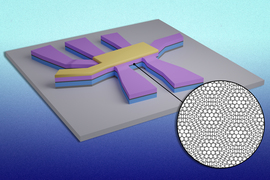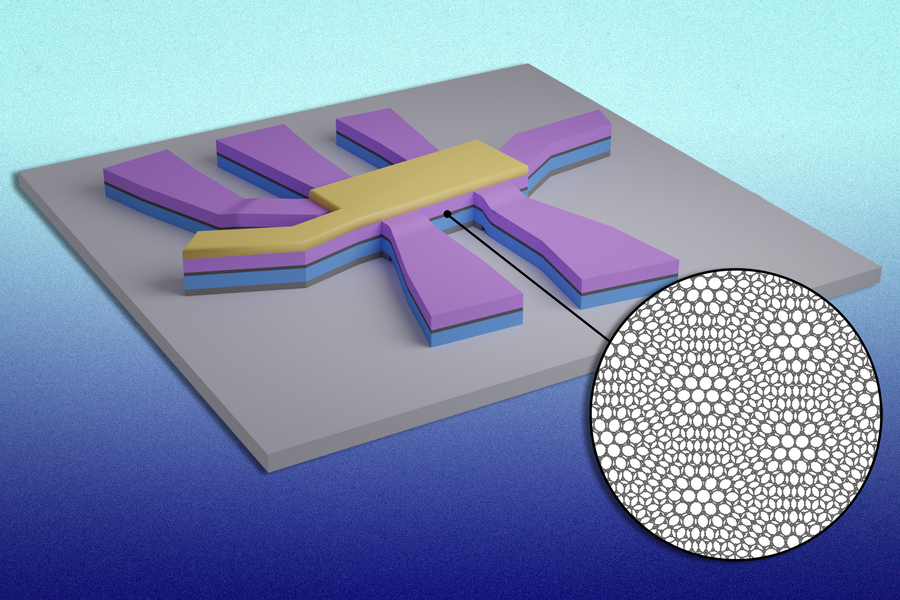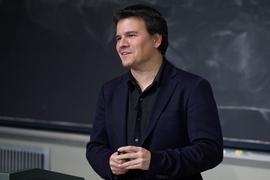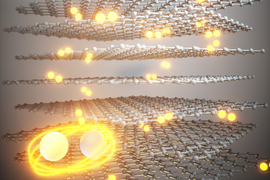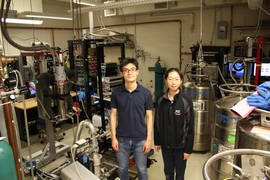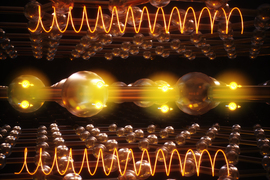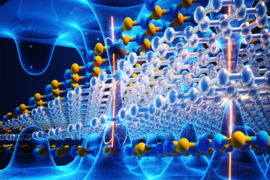With some careful twisting and stacking, MIT physicists have revealed a new and exotic property in “magic-angle” graphene: superconductivity that can be turned on and off with an electric pulse, much like a light switch.
The discovery could lead to ultrafast, energy-efficient superconducting transistors for neuromorphic devices — electronics designed to operate in a way similar to the rapid on/off firing of neurons in the human brain.
Magic-angle graphene refers to a very particular stacking of graphene — an atom-thin material made from carbon atoms that are linked in a hexagonal pattern resembling chicken wire. When one sheet of graphene is stacked atop a second sheet at a precise “magic” angle, the twisted structure creates a slightly offset “moiré” pattern, or superlattice, that is able to support a host of surprising electronic behaviors.
In 2018, Pablo Jarillo-Herrero and his group at MIT were the first to demonstrate magic-angle twisted bilayer graphene. They showed that the new bilayer structure could behave as an insulator, much like wood, when they applied a certain continuous electric field. When they upped the field, the insulator suddenly morphed into a superconductor, allowing electrons to flow, friction-free.
That discovery was a watershed in the field of “twistronics,” which explores how certain electronic properties emerge from the twisting and layering of two-dimensional materials. Researchers including Jarillo-Herrero have continued to reveal surprising properties in magic-angle graphene, including various ways to switch the material between different electronic states. So far, such “switches” have acted more like dimmers, in that researchers must continuously apply an electric or magnetic field to turn on superconductivity, and keep it on.
Now Jarillo-Herrero and his team have shown that superconductivity in magic-angle graphene can be switched on, and kept on, with just a short pulse rather than a continuous electric field. The key, they found, was a combination of twisting and stacking.
In a paper appearing today in Nature Nanotechnology, the team reports that, by stacking magic-angle graphene between two offset layers of boron nitride — a two-dimensional insulating material — the unique alignment of the sandwich structure enabled the researchers to turn graphene’s superconductivity on and off with a short electric pulse.
“For the vast majority of materials, if you remove the electric field, zzzzip, the electric state is gone,” says Jarillo-Herrero, who is the Cecil and Ida Green Professor of Physics at MIT. “This is the first time that a superconducting material has been made that can be electrically switched on and off, abruptly. This could pave the way for a new generation of twisted, graphene-based superconducting electronics.”
His MIT co-authors are lead author Dahlia Klein PhD ’21, graduate student Li-Qiao Xia, and former postdoc David MacNeill, along with Kenji Watanabe and Takashi Taniguchi of the National Institute for Materials Science in Japan.
Flipping the switch
In 2019, a team at Stanford University discovered that magic-angle graphene could be coerced into a ferromagnetic state. Ferromagnets are materials that retain their magnetic properties, even in the absence of an externally applied magnetic field.
The researchers found that magic-angle graphene could exhibit ferromagnetic properties in a way that could be tuned on and off. This happened when the graphene sheets were layered between two sheets of boron nitride such that the crystal structure of the graphene was aligned to one of the boron nitride layers. The arrangement resembled a cheese sandwich in which the top slice of bread and the cheese orientations are aligned, but the bottom slice of bread is rotated at a random angle with respect to the top slice. The result intrigued the MIT group.
“We were trying to get a stronger magnet by aligning both slices,” Jarillo-Herrero says. “Instead, we found something completely different.”
In their current study, the team fabricated a sandwich of carefully angled and stacked materials. The “cheese” of the sandwich consisted of magic-angle graphene — two graphene sheets, the top rotated slightly at the “magic” angle of 1.1 degrees with respect to the bottom sheet. Above this structure, they placed a layer of boron nitride, exactly aligned with the top graphene sheet. Finally, they placed a second layer of boron nitride below the entire structure and offset it by 30 degrees with respect to the top layer of boron nitride.
The team then measured the electrical resistance of the graphene layers as they applied a gate voltage. They found, as others have, that the twisted bilayer graphene switched electronic states, changing between insulating, conducting, and superconducting states at certain known voltages.
What the group did not expect was that each electronic state persisted rather than immediately disappearing once the voltage was removed — a property known as bistability. They found that, at a particular voltage, the graphene layers turned into a superconductor, and remained superconducting, even as the researchers removed this voltage.
This bistable effect suggests that superconductivity can be turned on and off with short electric pulses rather than a continuous electric field, similar to flicking a light switch. It isn’t clear what enables this switchable superconductivity, though the researchers suspect it has something to do with the special alignment of the twisted graphene to both boron nitride layers, which enables a ferroelectric-like response of the system. (Ferroelectric materials display bistability in their electric properties.)
“By paying attention to the stacking, you could add another tuning knob to the growing complexity of magic-angle, superconducting devices,” Klein says.
For now, the team sees the new superconducting switch as another tool researchers can consider as they develop materials for faster, smaller, more energy-efficient electronics.
“People are trying to build electronic devices that do calculations in a way that’s inspired by the brain,” Jarillo-Herrero says. “In the brain, we have neurons that, beyond a certain threshold, they fire. Similarly, we now have found a way for magic-angle graphene to switch superconductivity abruptly, beyond a certain threshold. This is a key property in realizing neuromorphic computing.”
This research was supported in part by the U.S. Air Force Office of Scientific Research, the U.S. Army Research Office, and the Gordon and Betty Moore Foundation.
